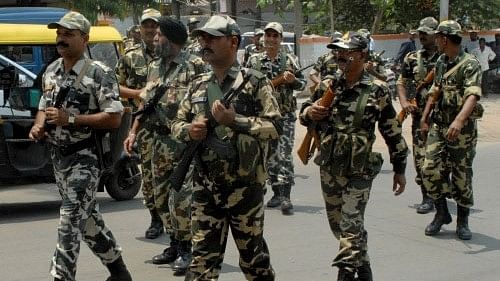
Representative image of police personnel.
Credit: DH Photo
New Delhi: Three battalions of the BSF comprising more than 3,000 personnel will move across the border from Odisha to Chhattisgarh and an equal number of ITBP units will further move into the Naxal stronghold of Abujhmad as part of a strategy to intensify anti-Maoist operations in their last bastions, official sources said.
The new operational blueprint is part of a plan under which Union Home Minister Amit Shah recently made a declaration that India was 'on the verge of' eliminating Left Wing Extremism (LWE).
"The last strike against LWE by forces such as the BSF, the CRPF and the ITBP is in the process. We are determined to end Naxalism in the country," Shah said on December 1 in Hazaribag, Jharkhand while addressing BSF troops on their 59th raising day.
These forces are called as Central Armed Police Forces (CAPFs).
Sources in the security establishment told PTI that the Border Security Force (BSF) has been directed to create six new COBs or company operating bases in Chhattisgarh's Narayanpur district by initially moving one of its battalion based in Odisha's Malkangiri, just across the inter-state border.
A BSF battalion has a strength of over 1,000 personnel.
The Indo-Tibetan Border Police (ITBP), which currently has about eight battalions located in Narayanpur, Rajnandgaon and Kondagaon districts of Chhattisgarh, has been asked to move one unit further inside the core area of Abujhmad.
This is an about 4,000 sq km forest area in Narayanpur district and is considered a stronghold of armed Naxal cadres.
The uncharted Abhujmad or 'madh' forests are host to a population of about 35,000 people, mainly tribals, residing in around 237 villages. The area, at present, has no permanent central or state police base and armed Maoist cadres are stated to be operating, training and moving here from across the Chhattisgarh-Odisha border in south Bastar region of the state.
The Bastar region comprising districts like Dantewada, Sukma and Bijapur up to Narayanpur and Kondagaon and Kanker district further north is the last bastion and corridor where Maoists have some strength and can spring surprises against the security forces and the administration.
The security forces are building their new strength and infrastructure here to demolish the Maoist network and hold the area so that development works can be initiated by the state government, a senior officer said.
He said two more BSF and ITBP battalions each will be later moved to further dominate the Chhattisgarh-Odisha border along south Bastar.
A second security officer said the Naxals are using the Bastar corridor of Chhattisgarh to move back and forth into Odisha districts like Malkangiri, Koraput and Kandhmal and hence the central forces have been tasked to create more COBs or forward operating bases along the border of these two states.
While there are around 800-900 active cadres in Chhattisgarh's Dandakaranya Special Zonal Committee leadership of the Naxals, the CPI(Maoist) strength in Odisha under the Kandhamal-Kalahandi-Boudh-Nayagarh (KKBN) division is depleted with only 242 active cadre, the second officer said.
Out of the 242, only 13 are from Odisha while the rest of the senior and middle-rung leadership of the Maoists hail from Chhattisgarh. Hence, the operations in Chhattisgarh are to be intensified as part of an operation that could be code named 'Kagar' (edge) during a meeting of various agencies to be held in January, he said.
Home minister Shah said on the BSF raising day that in the last 10 years, incidents of Naxal violence have gone down by 52 per cent, deaths in these incidents declined by 70 per cent and the number of affected districts have come down from 96 to 45. The number of 'LWE-hit police stations have come down from 495 to 176, he had said.
Shah said the Modi government was 'on the verge of' eliminating the LWE violence in various states.
He also counted the recent operations undertaken by security forces in the hills and forests of 'Burapahar' and 'Chakarbandha' in Jharkhand that freed vast tracts of areas from the clutches of Maoists.